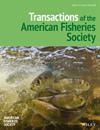觅食地点选择和面积的异速变化增加了黄石切喉鳟的能量摄入,但受到捕获猎物功能限制的制约
IF 1.4
3区 农林科学
Q2 FISHERIES
引用次数: 0
摘要
目标对于觅食动物来说,能量获取往往受到猎物丰度和捕获足够食物所需空间大小的相互作用的影响。合适的栖息地包括那些猎物捕获率足以满足生长和繁殖所需能量的地点。因此,量化觅食动物的空间利用如何随能量需求而变化,以及猎物密度如何影响猎物捕获率,有助于深入了解创造适宜栖息地的机制。在这里,我们有兴趣评估体型如何影响黄石切喉鳟的觅食地点选择、空间利用和能量摄入。结果我们发现,物理栖息地特征(如流速、水深和觅食距离)与鱼体大小呈正相关,但当将觅食面积与空间利用模型进行比较时,我们发现黄石切喉鳟捕获猎物所使用的空间比模型预测的要小。这些数据表明,黄石切喉鳟在觅食栖息地利用方面显示出异速变化:较大的鱼可以占据更深、更快的区域,从而提高猎物相遇率,但随着猎物相遇率的提高,觅食率会受到个体识别、追逐和处理猎物能力的限制。本文章由计算机程序翻译,如有差异,请以英文原文为准。
Allometric shifts in foraging site selection and area increase energy intake for Yellowstone Cutthroat Trout but are constrained by functional limits to prey capture
ObjectiveFor foraging animals, energy acquisition is often influenced by an interaction of prey abundance and the amount of space needed to capture sufficient food. Suitable habitat includes those locations where prey capture rates are sufficient to meet energetic requirements for growth and reproduction. Hence, quantifying how space use changes with energy requirements and how prey densities affect prey capture rates in foraging animals provides insight into the mechanisms that create suitable habitat. Here, we were interested in assessing how body size influences foraging site selection, space use, and energy intake by Yellowstone Cutthroat Trout Oncorhynchus virginalis bouvieri . Furthermore, we sought to quantify how foraging rates changed with increasing levels of food.MethodsWe recorded Yellowstone Cutthroat Trout foraging behavior in natural streams and measured space use and foraging rates using three‐dimensional videography.ResultWe found that physical habitat features, such as current velocity, water depth, and foraging distance, were positively correlated with fish body size, but when foraging area was compared to a model of space use, we found that Yellowstone Cutthroat Trout used less space to capture prey than the model predicted. Fish foraging rates and estimated energy intake also increased with increasing prey availability; however, trout captured prey according to a type II functional response, indicating an upper limit to prey capture from handling time constraints.ConclusionThese data demonstrate that Yellowstone Cutthroat Trout display allometric changes in foraging habitat use: larger fish can occupy deeper and faster areas that increase prey encounter rates, but as prey encounter rates increase, the foraging rates become limited by an individual's ability to identify, pursue, and handle prey items.
求助全文
通过发布文献求助,成功后即可免费获取论文全文。
去求助
来源期刊
CiteScore
2.90
自引率
7.10%
发文量
48
审稿时长
8-16 weeks
期刊介绍:
Transactions of the American Fisheries Society is a highly regarded international journal of fisheries science that has been published continuously since 1872. It features results of basic and applied research in genetics, physiology, biology, ecology, population dynamics, economics, health, culture, and other topics germane to marine and freshwater finfish and shellfish and their respective fisheries and environments.

 求助内容:
求助内容: 应助结果提醒方式:
应助结果提醒方式:


